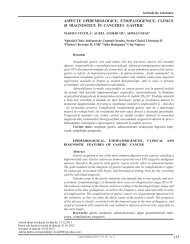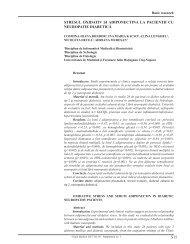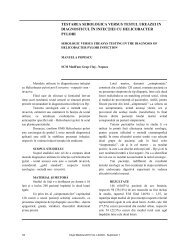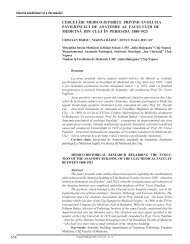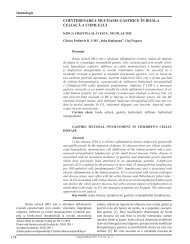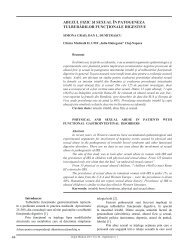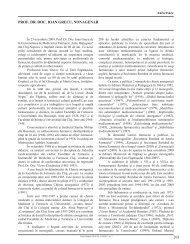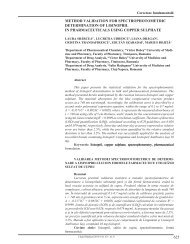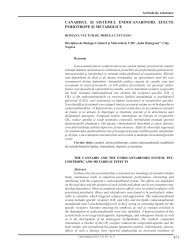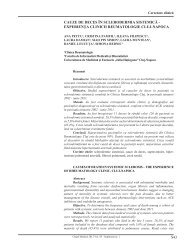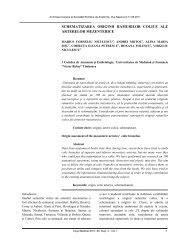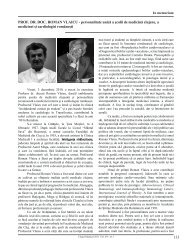RevistÄ de MedicinÄ Åi Farmacie - Clujul Medical - Iuliu HaÅ£ieganu
RevistÄ de MedicinÄ Åi Farmacie - Clujul Medical - Iuliu HaÅ£ieganu
RevistÄ de MedicinÄ Åi Farmacie - Clujul Medical - Iuliu HaÅ£ieganu
Create successful ePaper yourself
Turn your PDF publications into a flip-book with our unique Google optimized e-Paper software.
Patologie neurologică<br />
nonsteroidiene [23].<br />
Artefactele acustice ale aparatului <strong>de</strong> stimulare magnetică<br />
pot <strong>de</strong>păşi pragul sonor, <strong>de</strong>venind supărătoare pentru<br />
pacient, fapt ce se poate ameliora prin aplicarea <strong>de</strong> dopuri pentru<br />
urechi [24].<br />
Singura complicaţie importantă <strong>de</strong>scrisă până acum<br />
este <strong>de</strong>clanşarea crizelor epileptice. La frecvenţe şi intensităţi<br />
crescute <strong>de</strong> stimulare şi interval scurt între stimulări, precum şi<br />
după serii prelungite <strong>de</strong> stimulări apare o creştere a excitabilităţii<br />
corticale ce predispune la aparţia <strong>de</strong> crize epileptice [5]. Chiar<br />
şi la pacienţii fără epilepsie sau modificări structurale cerebrale<br />
se pot <strong>de</strong>clanşa crize epileptice [25,26]. Dacă pacienţii sunt<br />
sub tratament cu neuroleptice sau anti<strong>de</strong>presive creşte riscul<br />
<strong>de</strong> crize epileptice [25]. Cel mai a<strong>de</strong>sea crizele sunt <strong>de</strong>clanşate<br />
<strong>de</strong> stimularea cortexului motor, dar s-au întâlnit crize şi după<br />
stimularea cortexului prefrontal [27]. S-au stabilit criterii <strong>de</strong><br />
siguranţă pentru TMS, dar cu toate acestea, crizele pot apărea.<br />
rTMS este o metodă cu efecte secundare rare, dar care pot fi<br />
importante, <strong>de</strong> aceea ea trebuie aplicată numai sub atenta<br />
supraveghere a unui medic specializat în această tehnică [28].<br />
Bibliografie<br />
1. Jankovic J., Tolosa E., Editors: Parkinson ‘s Disease and Movement<br />
Disor<strong>de</strong>rs. 5 th edition. Lippincott Williams&Wilkins. Phila<strong>de</strong>lphia;<br />
2007, p: 1-14<br />
2. Rothwell J.C., Thompson P.D., Day B.L., Boyd S., Mars<strong>de</strong>n C.D.:<br />
Stimulation of the human motor cortex through the scalp. Experimental<br />
Physiology 1992;76:159-200<br />
3. Siebner H.R.: Neues aus <strong>de</strong>r Neurophysiologie: die repetitive<br />
transkranielle magnetstimulation. Nervenheilkun<strong>de</strong> 1999;18:467-74<br />
4. Wassermann E.M.: Risk and safety of repetitive transcranial<br />
magnetic stimulation: report and suggested gui<strong>de</strong>lines from the<br />
International Workshop on Safety of Repetitive Transcranial Magnetic<br />
Stimulation. Electroenceph Clin Neurophys l08(l998):l-16.<br />
5. Schönfeldt-Lecuona C, Herwig U.: Die transkranielle<br />
Magnetstimulation (TMS) in <strong>de</strong>r Psychiatrie. Nervenheilkun<strong>de</strong> 1999;<br />
18:342-52.<br />
6. Wassermann E.M., Cohen L.G., Flitman S.S., Chen R., Hallett M.:<br />
Seizures in health people with repeated ‘safe’ trains of transcranial<br />
magnetic stimuli. Lancet 1996; 347: 825-826.<br />
7. Boyd S.G., Tothwell J.C., Cowan J.M.A.: A method of monitoring<br />
function in cortical pathways during scoliosis surgery with a note on<br />
motor conduction velocities. J Neurol Neurosurg Psych 1986;49:251-<br />
257<br />
8. Day B.L., Dressler D., Maertens De Noordhout A.: Electric and<br />
magnetic stimulation of human motor cortex: surface EMG and single<br />
motor unit responses. J Physiol 1989;412:449-473<br />
9. Berar<strong>de</strong>lli A., Rona S., inghilleriM., ManfrediM.: Cortical inhibition<br />
in Parkinson’s disease. A study with paired magnetic stimulation. Brain<br />
1996; 119,71-77<br />
10. Cantello R., Gianelli M., Bettucci D., Civardi C, De Angelis<br />
M.S., Mutani R.: Parkinson’s disease rigidity: magnetic motor evoked<br />
potentials in a small hand muscle. Neurology 1991; 41: 1449-56.<br />
11. Davey N.J., Dick J.P.R., Ellaway P.H., Maskill D.W. : Raised<br />
motor cortical threshold associated with bradykinesia as revealed by<br />
transcranial magnetic stimulation in normal man and Parkinson’s<br />
disease [abstract]. J Physiol (Lond) 1991; 438: 35P<br />
12. Priori A., Berar<strong>de</strong>lli A., Inghilleri M., Accornero N., Manfredi M.:<br />
Motor cortical inhibition and the dopaminergic system. Brain 1994;<br />
117: 317-23<br />
13. Valls-Sole’ J., Pascual-Leone A., Brasil-Neto J.P., Cammarota<br />
A., McShane L., Hallett M.: Abnormal facilitation of the response to<br />
transcranial magnetic stimulation in patients with Parkinson’s disease.<br />
Neurology 1994; 44: 735-41.<br />
14. Ridding M.C., Inzelberg R., Rothwell J.C.: Changes in excitability<br />
of motor cortical circuitry in patients with Parkinson’s disease. Ann<br />
Neural 1995; 37: 181-8.<br />
15. Fuhr P., Agostino R., Hallett M.: Spinal motor neuron excitability<br />
during the silent period after cortical stimulation. Electroencephalogr<br />
Clin Neurophysiol 1991; 81: 257-62.<br />
16. Inghilleri M., Berar<strong>de</strong>lli A., Cruccu G.,<br />
Manfredi M.: Silent period evoked by transcranial<br />
stimulation of the human cortex and cervicomedullary junction. J<br />
Physiol (Lond) 1993; 466: 521-34<br />
17. Roick H., Von Giesen H.J., Benecke R.: On the origin of the<br />
postexcitatory inhibition seen after transcranial magnetic brain<br />
stimulation in awake human subjects. Exp Brain Res 1993; 94:489-<br />
98.<br />
18. Wilson S.A., Lockwood R.J., Thickbroom G.W., Mastaglia F.L.<br />
:The muscle silent period following transcranial magnetic cortical<br />
stimulation. J Neurol Sci 1993; 114:216-22<br />
19. George M.S., Nahas Z., Kozel A., Xingbao L., Yamanaka K.,<br />
Mishory A., Bohning D.E.: Mechanism and the current state of<br />
transcranial magnetic stimulation. CNS Spectrums 2003 ;8(7): 496-<br />
514.<br />
20. Buhmann C, Gorsler A., Baumer T., Hidding U., Demiralaz C,<br />
Hinkelmann K.: Abnormal excitability of premotor-motor connections<br />
in <strong>de</strong> novo Parkinson’s disease. Brain 2004,124:2732-2746<br />
21. lefaucheur J.P.: Repetitive transcranial magnetic stimulation<br />
(rTMS): insights into the treatment of Parkinson’s disease by cortical<br />
stimulation. Neurophysiol Clin 2006 May-Jun;36(3): 125-33<br />
22. Popescu CD., Bohotin V., Ignat B., Bohotin C: Stimularea<br />
magnetica transcraniana, Rev Medic.ro, nr 31 suplim, [25.06.2008]<br />
http://medic.pulsmedia.ro/article--x-Supliment-Stimularea_<br />
magnetica_transcraniana— 2081.html<br />
23. Machii K., Cohen D., Ramos-Estebanez C, Pascual-Leone A.:<br />
Safety of rTMS to non-motor cortical areas in healthy participants and<br />
patients. Clin Neurophysiol. 2006 Feb; 117(2):455-71.<br />
24. Wassermann E.M.: Si<strong>de</strong> effects of repetitive transcranial magnetic<br />
stimulation. Depress Anxiety 200; 12: 124-129.<br />
25. Pascual-Leone A., Houser CM., Reese K., Shotland LX, Grafman<br />
J., Sato S. et al.: Safety of rapid-rate transcranial magnetic stimulation<br />
in normal volunteers. Electroencephalogr Clin Neurophysiol.<br />
1993;89(2):120-30.<br />
26. Conca A., König P.D., Hausmann A.: Transcranial magnetic<br />
stimuation induces ‘pseudoabsence seizure’. Acta Psychiatr Scand<br />
2000; 101: 246-249<br />
27. Lorberbaum J.P., Wassermann E.M.: Safety concerns of TMS.<br />
Transcranial Magnetic Stimulation in Neuropsychiatry. R. H. Belmaker.<br />
Washington, DC, American Psychiatrie Press, Inc.: 2000;S. 141-163.<br />
28. Belmaker R.H., Fitzgerald P., George M.S., Lisanby S.H., Pascual-<br />
Leone A., Schlaepfer T.E., Wassermann E.M.: Managing the risks of<br />
repetitive transcranial magnetic stimulation. CNS Spectrums 2003;8(7):<br />
489.<br />
332<br />
<strong>Clujul</strong> <strong>Medical</strong> 2009 Vol. LXXXII - nr. 3



